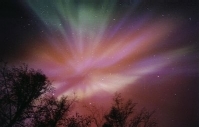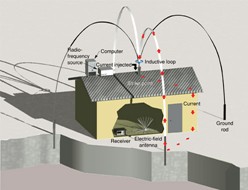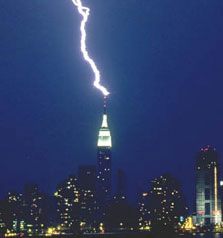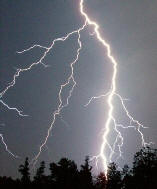
early research • modern
research • types of lightning •
lightning safety •
facts & trivia
Lightning
is a powerful
natural electrostatic discharge produced during a thunderstorm. Lightning's
abrupt electric discharge is accompanied by the emission of visible light and
other forms of electromagnetic radiation. The electric current passing through
the discharge channels rapidly heats and expands the air into plasma, producing
acoustic shock waves (thunder) in the atmosphere.
How lightning is formed:
The first process in the generation of lightning is the forcible
separation of positive and negative charge carriers within a cloud or air. The
mechanism by which this happens is still the subject of research, but one widely
accepted theory is the polarization mechanism. This mechanism has two
components: the first is that falling droplets of ice and rain become
electrically polarized as they fall through the atmosphere's natural electric
field, and the second is that colliding ice particles become charged by
electrostatic induction. Once charged, by whatever mechanism, work is performed
as the opposite charges are driven apart and energy is stored in the electric
fields between them. The positively charged crystals tend to rise to the top,
causing the cloud top to build up a positive charge, and the negatively charged
crystals and hailstones drop to the middle and bottom layers of the cloud,
building up a negative charge. Cloud-to-cloud lightning can appear at this
point. Cloud-to-ground lightning is less common. Cumulonimbus clouds that do not
produce enough ice crystals usually fail to produce enough charge separation to
cause lightning.
When sufficient negatives and positives gather in this way, and when the
electric field becomes sufficiently strong, an electrical discharge occurs
within the clouds or between the clouds and the ground, producing the bolt. It
has been suggested by experimental evidence that these discharges are triggered
by cosmic ray strikes which ionize atoms, releasing electrons that are
accelerated by the electric fields, ionizing other air molecules and making the
air conductive by a runaway breakdown, then starting a lightning strike. During
the strike, successive portions of air become conductive as the electrons and
positive ions of air molecules are pulled away from each other and forced to
flow in opposite directions (stepped channels called step leaders). The
conductive filament grows in length. At the same time, electrical energy stored
in the electric field flows radially inward into the conductive filament.
When a charged step leader is near the ground, opposite charges appear on the
ground and enhance the electric field. The electric field is higher on trees and
tall buildings. If the electric field is strong enough, a discharge can initiate
from the ground. This discharge starts as positive streamer and, if it develops
as a positive leader, can eventually connect to the descending discharge from
the cloud.
Lightning can also occur within the ash clouds from volcanic eruptions, or can
be caused by violent forest fires which generate sufficient dust to create a
static charge.
A bolt of lightning usually begins when an invisible negatively charged stepped
leader stroke is sent out from the cloud. As it does so, a positively charged
streamer is usually sent out from the positively charged ground or cloud. When
the two leaders meet, the electric current greatly increases. The region of high
current propagates back up the positive stepped leader into the cloud. This
"return stroke" is the most luminous part of the strike, and is the part that is
really visible. Most lightning strikes usually last about a quarter of a second.
Sometimes several strokes will travel up and down the same leader strike,
causing a flickering effect. This discharge rapidly superheats the leader
channel, causing the air to expand rapidly and produce a shock wave heard as
thunder.
|
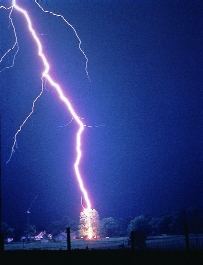
Courtesy - NOAA |
It is possible for streamers to be sent out from several different objects
simultaneously, with only one connecting with the leader and forming the
discharge path. Photographs have been taken on which non-connected streamers are
visible such as that shown on the right.
This type of lightning is known as negative lightning because of the discharge
of negative charge from the cloud, and accounts for over 95% of all lightning.
An average bolt of negative lightning carries a current of 30 kiloamperes,
transfers a charge of 5 coulombs, has a potential difference of about 100
megavolts and dissipates 500 mega joules (enough to light a 100 watt light bulb
for 2 months).
Positive lightning makes up less than 5 % of all lightning. It occurs when the
stepped leader forms at the positively charged cloud tops, with the consequence
that a negatively charged streamer issues from the ground. The overall effect is
a discharge of positive charges to the ground. Research carried out after the
discovery of positive lightning in the 1970s showed that positive lightning
bolts are typically six to ten times more powerful than negative bolts, last
around ten times longer, and can strike several kilometers or miles distant from
the clouds. During a positive lightning strike, huge quantities of ELF and VLF
radio waves are generated.
As a result of their power, positive lightning strikes are considerably more
dangerous. At the present time, aircraft are not designed to withstand such
strikes, since their existence was unknown at the time standards were set, and
the dangers unappreciated until the destruction of a glider in 1999.
Positive lightning is also now believed to have been responsible for the 1963
in-flight explosion and subsequent crash of Pan Am Flight 214, a Boeing 707.
Subsequently, aircraft operating in U.S. airspace have been required to have
lightning discharge wicks to reduce the chances of a similar occurrence.
Positive lightning has also been shown to trigger the occurrence of upper
atmospheric lightning. It tends to occur more frequently in winter storms and at
the end of a thunderstorm.
An average bolt of positive lightning carries a current of 300 kiloamperes
(about ten times as much current as a bolt of negative lightning), transfers a
charge of up to 300 coulombs, has a potential difference up to 1 gigavolt (a
thousand million volts), dissipates enough energy to light a 100 watt light bulb
for up to 95 years, and lasts for tens or hundreds of milliseconds.
Heinz Kasemir first hypothesized that a lightning leader system actually
develops in a bipolar fashion, with both a positive and a negative branching
leader system connected at the system origin and containing a net zero charge.
This process provides a means for the positive leader to conduct away the net
negative charge collected during development, allowing the leader system to act
as an extending polarized conductor. Such a polarized conductor would be able to
maintain intense electric fields at its ends, supporting continued leader
development in weak-background electric fields.
During the eighties, flight tests showed that aircraft can trigger a bipolar
stepped leader when crossing charged cloud areas. Many scientists think that
positive and negative lightning in a cloud are actually bipolar lightning.
To spontaneously ionize air and conduct electricity across it, an electric field
of field strength of approximately 2500 kilovolts per meter is required.
However, measurements inside storm clouds to date have failed to locate fields
this strong, with typical fields being between 100 and 400 kilovolts per meter.
While there remains a possibility that researchers are failing to encounter the
small high-strength regions of the large clouds, the odds of this are
diminishing as further measurements continue to fall short.
A theory by Alex Gurevich of the Lebedev Physical Institute in 1992 proposes
that cosmic rays may provide the beginnings of what he called a runaway
breakdown. Cosmic rays strike an air molecule and release extremely energetic
electrons having enhanced mean free paths of tens of centimeters. These strike
other air molecules, releasing more electrons which are accelerated by the
storm's electric field, forming a chain reaction of long-trajectory electrons
and creating a conductive plasma many tens of meters in length. This was
initially considered a fringe theory, but is now becoming mainstream because of
the lack of other theories.
It has been recently revealed that most lightning emits an intense burst of
X-rays and/or gamma-rays which seem to be produced during the stepped-leader and
dart-leader phases just before the stroke becomes visible. The X-ray bursts
typically have a total duration of less than 100 microseconds and have energies
extending up to nearly a few hundred thousand electron volts (How
big is an electron volt). The presence of these high-energy
events match and support the "runaway breakdown" theory, and were discovered
through the examination of rocket-triggered lightning, and from satellite
monitoring of natural lightning.
NASA's RHESSI satellite typically reports 50 gamma-ray events per day, and many
of these are strong enough to fit the theory. Additionally, low-frequency radio
emissions detected at ground level can detect lightning bolts from upwards of
4000 km away; combining these with gamma-ray burst events detected from above
show overlapping positions and timing.
There are problems with the "runaway breakdown" theory, however. While there
seems to be a strong correlation between gamma-ray events and lightning, there
are insufficient events detected to account for the amount of lightning
occurring across the planet. Another issue is the amount of energy the theory
states is required to initiate the breakdown. Cosmic rays of sufficient energy
strike the atmosphere on average only once per 50 seconds per square kilometer.
Measured X-ray burst intensity also falls short, with results indicating
particle energy 1/20th of the theory's value.
return to
top
Early lightning research: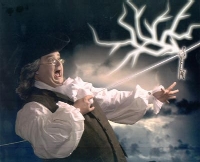
During early investigations into electricity via Leyden jars and
other instruments, a number of people (Dr. Wall, Gray, and Abbé Nollet) proposed
that small-scale sparks shared some similarity with lightning.
Benjamin Franklin, who also invented the lightning rod, endeavored to test this
theory using a spire which was being erected in Philadelphia. Whilst he was
waiting for the spire completion, some others (Dalibard and De Lors) conducted
at Marly in France what became to be known as the Philadelphia experiments that
Franklin had suggested in his book.
Franklin usually gets the credit, as he was the first to suggest this
experiment. The Franklin experiment is as follows:
While waiting for completion of the spire, he got the idea of using a flying
object, such as a kite, instead. During the next thunderstorm, which was in June
1752, he raised a kite, accompanied by his son as an assistant. On his end of
the string he attached a key and tied it to a post with a silk thread. As time
passed, Franklin noticed the loose fibers on the string stretching out; he then
brought his hand close to the key and a spark jumped the gap. The rain which had
fallen during the storm had soaked the line and made it conductive.
However, in his autobiography (written 1771-1788, first published 1790),
Franklin clearly states that he performed this experiment after those in France,
which occurred weeks before his own experiment, without his prior knowledge as
of 1752.
As news of the experiment and its particulars spread, the experiment was met
with attempts at replication. However, experiments involving lightning are
always risky and frequently fatal. The most well-known death during the spate of
Franklin imitators was that of Professor Georg Richmann, of Saint Petersburg,
Russia. He had created a set-up similar to Franklin's, and was attending a
meeting of the Academy of Sciences when he heard thunder. He ran home with his
engraver to capture the event for posterity. While the experiment was underway,
a large ball lightning showed up, collided with Richmann's head, and killed him,
leaving a red spot. His shoes were blown open, parts of his clothes singed, the
engraver knocked out, the doorframe of the room split, and the door itself torn
off its hinges.
return to
top
Modern research:
Although experiments from the time of Franklin showed that
lightning was a discharge of static electricity, there was little improvement in
theory for more than 150 years. The impetus for new research was from the field
of power engineering: power transmission lines came into use, and engineers
needed to know much more about lightning. Although causes were debated (and are
today to some extent), research produced a wealth of new information about
lightning phenomena, especially amounts of current and energy involved. The
following picture emerged:
An initial discharge, (or path of ionized air), called a "stepped leader",
starts from the thundercloud and proceeds generally downward in a number of
quick jumps, typical length 50 meters, but taking a relatively long time (200
milliseconds) to reach the ground. This initial phase involves a small electric
current and is almost invisible compared to the later effects. When the downward
leader is quite close, a small discharge comes up from a grounded (usually tall)
object because of the intensified electric field.
Once the ground discharge meets the stepped leader, the circuit is closed, and
the main stroke follows with much higher current. The main stroke travels at
about 0.1 c (100 million feet per second) and has high current for 100
microseconds or so. It may persist for longer periods with lower current.
In addition, lightning often contains a number of restrikes, separated by a much
larger amount of time, 30 milliseconds being a typical value. This rapid
restrike effect was probably known in antiquity, and the "strobe light" effect
is often quite noticeable.
Positive lightning does not generally fit the above pattern.
return to
top
Types of lightning: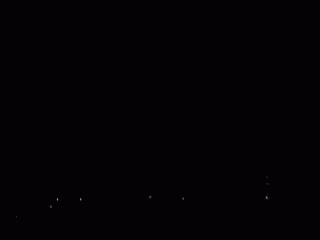
Intracloud lightning, sheet lightning, anvil
crawlers
Intracloud lightning is the most common type of lightning
which occurs completely inside one cumulonimbus cloud, and is
commonly called an anvil crawler. Discharges of electricity in
anvil crawlers travel up the sides of the cumulonimbus cloud
branching out at the anvil top.
Cloud-to-ground lightning, anvil-to-ground lightning
Cloud-to-ground lightning is a great lightning discharge between a
cumulonimbus cloud and the ground initiated by the downward-moving leader
stroke. This is the second most common type of lightning. One special type of
cloud-to-ground lightning is anvil-to-ground lightning, a form of positive
lightning, since it emanates from the anvil top of a cumulonimbus cloud where
the ice crystals are positively charged. In anvil-to-ground lightning, the
leader stroke issues forth in a nearly horizontal direction till it veers toward
the ground. These usually occur miles ahead of the main storm and will strike
without warning on a sunny day. They are signs of an approaching storm and are
known colloquially as "bolts from the blue".
Bead lightning, ribbon lightning, staccato lightning
Another special type of cloud-to-ground lightning is bead
lightning. This is a regular cloud-to-ground stroke that contains a higher
intensity of luminosity. When the discharge fades it leaves behind a string of
beads effect for a brief moment in the leader channel. A third special type of
cloud-to-ground lightning is ribbon lightning. These occur in thunderstorms
where there are high cross winds and multiple return strokes. The winds will
blow each successive return stroke slightly to one side of the previous return
stoke, causing a ribbon effect. The last special type of cloud-to-ground
lightning is staccato lightning, which is nothing more than a leader stroke with
only one return stroke.
Cloud-to-cloud lightning
Cloud-to-cloud or intercloud lightning is a somewhat rare type
of discharge lightning between two or more completely separate cumulonimbus
clouds.
Ground-to-cloud lightning
Ground-to-cloud lightning is a lightning discharge between the
ground and a cumulonimbus cloud from an upward-moving leader stroke. Most
ground-to-cloud lightning occurs from tall buildings, mountains and towers.
Heat lightning or summer lightning
Heat lightning (or, in the UK, "summer lightning") is nothing
more than the faint flashes of lightning on the horizon from distant
thunderstorms. Heat lightning was named because it often occurs on hot summer
nights. Heat lightning can be an early warning sign that thunderstorms are
approaching. In Florida, heat lightning is often seen out over the water at
night, the remnants of storms that formed during the day along a sea breeze
front coming in from the opposite coast.
Some cases of "heat lightning" can be explained by the refraction of sound by
bodies of air with different densities. An observer may see nearby lightning,
but the sound from the discharge is refracted over his head by a change in the
temperature, and therefore the density, of the air around him. As a result, the
lightning discharge appears to be silent.
Ball lightning
Ball lightning is described as a floating, illuminated ball that
occurs during thunderstorms. They can be fast moving, slow moving or nearly
stationary. Some make hissing or crackling noises or no noise at all. Some have
been known to pass through windows and even dissipate with a bang. Ball
lightning has been described by eyewitnesses but rarely, if ever, recorded by
meteorologists.
The engineer Nikola Tesla wrote, "I have succeeded in determining the mode of
their formation and producing them artificially" (Electrical World and Engineer,
5 March 1904). There is some speculation that electrical breakdown and arcing of
cotton and gutta-percha wire insulation used by Tesla may have been a
contributing factor, since some theories of ball lightning require the
involvement of carbonaceous materials. Some later experimenters have been able
to briefly produce small luminous balls by igniting carbon-containing materials
atop sparking Tesla Coils.
Several theories have been advanced to describe ball lightning, with none being
universally accepted. Any complete theory of ball lightning must be able to
describe the wide range of reported properties, such as those described in
Singer's book "The Nature of Ball Lightning" and also more contemporary
research. Japanese research shows that ball lightning has been seen several
times without any connection to stormy weather or lightning.
Ball lightning field properties are more extensive than realized by many
scientists not working in this field. The typical fireball diameter is usually
standardized as 20–30 cm, but ball lightning several meters in diameter has been
reported (Singer). A recent photograph by a Queensland ranger, Brett Porter,
showed a fireball that was estimated to be 100 meters in diameter. The
photograph has appeared in the scientific journal Transactions of the Royal
Society. The object was a glowing globular zone (the breakdown zone?) with a
long, twisting, rope-like projection (the funnel?).
Fireballs have been seen in tornadoes, and they have also split apart into two
or more separate balls and recombined. Fireballs have carved trenches in the
peat swamps in Ireland. Vertically linked fireballs have been reported. One
theory that may account for this wider spectrum of observational evidence is the
idea of combustion inside the low-velocity region of axisymmetric (spherical)
vortex breakdown of a natural vortex (e.g., the 'Hill's spherical vortex'). The
scientist Coleman was the first to propose this theory in 1993 in Weather, a
publication of the Royal Meteorological Society.
Ball lightning is hardly ever seen. In fact, there are only a few pictures of
it.
St Elmo's fire was correctly identified by Franklin as electrical in nature. It
is not the same as ball lightning.
|
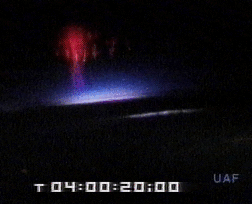
Sprite Discharge - Courtesy NASA |
Sprites, elves, jets, and other upper atmospheric lightning
Reports by scientists of strange lightning phenomena above
storms date back to at least 1886. However, it is only in recent years that
fuller investigations have been made. This has sometimes been called mega
lightning.
Sprites are now well-documented electrical discharges that occur high above the
cumulonimbus cloud of an active thunderstorm. They appear as luminous
reddish-orange, neon-like flashes, last longer than normal lower stratospheric
discharges (typically around 17 milliseconds), and are usually spawned by
discharges of positive lightning between the cloud and the ground. Sprites can
occur up to 50 km from the location of the lightning strike, and with a time
delay of up to 100 milliseconds. Sprites usually occur in clusters of two or
more simultaneous vertical discharges, typically extending from 65 to 75 km (40
to 47 miles) above the earth, with or without less intense filaments reaching
above and below. Sprites are preceded by a sprite halo that forms because of
heating and ionization less than 1 millisecond before the sprite. Sprites were
first photographed on July 6, 1989, by scientists from the University of
Minnesota and named after the mischievous sprites in the plays of Shakespeare.
Recent research carried out at the University of Houston in 2002 indicates that
some normal (negative) lightning discharges produce a sprite halo, the precursor
of a sprite, and that every lightning bolt between cloud and ground attempts to
produce a sprite or a sprite halo. Research in 2004 by scientists from Tohoku
University found that very low frequency emissions occur at the same time as the
sprite, indicating that a discharge within the cloud may generate the sprites.
Blue jets differ from sprites in that they project from the top of the
cumulonimbus above a thunderstorm, typically in a narrow cone, to the lowest
levels of the ionosphere 40 to 50 km (25 to 30 miles) above the earth. They are
also brighter than sprites and, as implied by their name, are blue in color.
They were first recorded on October 21, 1989, on a video taken from the space
shuttle as it passed over Australia.
Elves often appear as a dim, flattened, expanding glow around 400 km (250 miles)
in diameter that lasts for, typically, just one millisecond. They occur in
the ionosphere 100 km (60 miles) above the ground over thunderstorms. Their
color was a puzzle for some time, but is now believed to be a red hue. Elves
were first recorded on another shuttle mission, this time recorded off French
Guiana on October 7, 1990. Elves is a frivolous acronym for Emissions of Light
and Very Low Frequency Perturbations From Electromagnetic Pulse Sources. This
refers to the process by which the light is generated; the excitation of
nitrogen molecules due to electron collisions (the electrons having been
energized by the electromagnetic pulse caused by a positive lightning bolt).
On September 14, 2001, scientists at the Arecibo Observatory photographed a huge
jet double the height of those previously observed, reaching around 80 km (50
miles) into the atmosphere. The jet was located above a thunderstorm over the
ocean, and lasted under a second. Lightning was initially observed traveling up
at around 50,000 m/s in a similar way to a typical blue jet, but then divided in
two and sped at 250,000 m/s to the ionosphere, where they spread out in a bright
burst of light.
On July 22, 2002, five gigantic jets between 60 and 70 km (35 to 45 miles) in
length were observed over the South China Sea from Taiwan, reported in Nature. The jets lasted under a second, with shapes likened by the researchers to
giant trees and carrots.
Researchers have speculated that such forms of upper atmospheric lightning may
play a role in the formation of the ozone layer.
Triggered lightning
Lightning has been triggered directly by human activity in
several instances. Lightning struck the Apollo 12 soon after takeoff, and has
struck soon after thermonuclear explosions. It has also been triggered by
launching rockets carrying spools of wire into thunderstorms. The wire unwinds
as the rocket climbs, making a convenient path for the lightning to use. These
bolts are typically very straight.
Lightning throughout the Solar System
Lightning requires the electrical breakdown of gas, so lightning
cannot exist in the vacuum of space. However, lightning has been observed within
the atmospheres of other planets, such as Venus and Jupiter. Lightning on
Jupiter is estimated to be 100 times as powerful, but fifteen times less
frequent, than that which occurs on Earth. Lightning on Venus is still a
controversial subject after decades of study. During the Soviet Venera and U.S.
Pioneer missions of the '70s and '80s, signals suggesting lightning may be
present in the upper atmosphere were detected. However, recently the
Cassini-Huygens mission fly-by of Venus detected no signs of lightning at all.
return to
top
Lightning safety:
Thunderstorms are the primary source of lightning. Because
people have been struck many kilometers away from a storm, seeking immediate and
effective shelter when thunderstorms approach is an important part of lightning
safety. Contrary to popular notion, there is no 'safe' location outdoors. People
have been struck in sheds, makeshift shelters, etc. A better location would be
inside a vehicle (a crude type of Faraday cage). It is advisable to keep
appendages away from any attached metallic components once inside (keys in
ignition, etc.).
Several different types of devices, including lightning rods, lightning
arresters, and electrical charge dissipaters, are used to prevent lightning
damage and safely redirect lightning strikes.
Nearly 2000 persons per year in the world are injured by lightning strikes, and
between 25 to 33 % of those struck die. Lightning injuries result from three
factors: electrical damage, intense heat, and the mechanical energy which these
generate. While sudden death is common because of the huge voltage of a
lightning strike, survivors often fare better than victims of other electrical
injuries caused by a more prolonged application of lesser voltage.
Lightning can incapacitate humans in 4 different ways:
- Direct strike
- 'Splash' from nearby objects struck
- Ground strike near victim
- EMP or electro-magnetic pulse from close proximity strikes - especially during
positive lightning discharges
In a direct hit the electrical charge strikes the victim first.
Counter intuitively, if the victim's skin resistance is high enough, much of the
current will flash around the skin or clothing to the ground, resulting in a
surprisingly benign outcome. Splash hits occur when lightning effectively
bounces off a nearby object and strikes the victim en route to ground. Ground
strikes, in which the bolt lands near the victim and is conducted through the
victim via his or her connection to the ground (such as through the feet), can
cause great damage.
The most critical injuries are to the circulatory system, the lungs, and the
central nervous system. Many victims suffer immediate cardiac arrest and will
not survive without prompt emergency care, which is safe to administer because
the victim will not retain any electrical charge after the lightning has struck
(of course, the helper could be struck by a separate bolt of lightning in the
vicinity). Others incur myocardial infarction and various cardiac arrhythmias,
either of which can be rapidly fatal as well. The intense heat generated by a
lightning strike can cause lung damage, and the chest can be damaged by the
mechanical force of rapidly expanding heated air. Either the electrical or the
mechanical force can result in loss of consciousness, which is very common
immediately after a strike. Amnesia and confusion of varying duration often
result as well. A complete physical examination by paramedics or physicians may
reveal ruptured eardrums, and ocular cataracts may develop, sometimes more than
a year after an otherwise uneventful recovery.
The lightning often leaves skin burns in characteristic Lichtenberg figures,
sometimes called lightning flowers; they may persist for hours or days, and are
a useful indicator for medical examiners when trying to determine the cause of
death. They are thought to be caused by the rupture of small capillaries under
the skin, either from the current or from the shock wave. It is also speculated
that the EMP (electro-magnetic pulse) created by a nearby lightning strike can
cause cardiac arrest.
There is sometimes spectacular and unconventional lightning damage. Hot
lightning which lasts for more than a second can deposit immense energy, melting
or carbonizing large objects. One such example is the destruction of the
basement insulator of the 250-metre-high central mast of the long wave
transmitter at Orlunda, Sweeden, which led to its collapse.
return to
top
Facts and trivia:
A bolt of lightning can reach temperatures approaching 28,000
kelvins (50,000 degrees Fahrenheit) in a split second. This is about five times
hotter than the surface of the sun. The heat of lightning which strikes loose
soil or sandy regions of the ground may fuse the soil or sand into glass
channels called fulgurites. These are sometimes found under the sandy surfaces
of beaches and golf courses, or in desert regions. Fulgurites are evidence that
lightning spreads out into branching channels when it strikes the ground.
Trees are frequent conductors of lightning to the ground. Since sap is a poor conductor, its electrical resistance
causes it to be heated explosively into steam, which blows off the bark outside
the lightning's path. In following seasons trees overgrow the damaged area and
may cover it completely, leaving only a vertical scar. If the damage is severe,
the tree may not be able to recover, and decay sets in, eventually killing the
tree. Occasionally, a tree may explode completely. It is commonly thought that a tree standing alone is more
frequently struck, though in some forested areas, lightning scars can be seen on
almost every tree.
Of all common trees the most frequently struck is the oak. It has a deep central
root that goes beneath the tree, as well as hollow water-filled cells that run
up and down the wood of the oak's trunk. These two qualities make oak trees
better grounded and more conductive than trees with shallow roots and closed
cells.
- The odds of an average person living in the USA being struck by lightning once
in his lifetime has been estimated to be 1:3000.
- The city of Teresina in northern Brazil has the third-highest rate of
occurrences of lightning strikes in the world. The surrounding region is
referred to as the Chapada do Corisco ("Flash Lightning Flatlands").
- The United States is home to "Lightning Alley", a group of states in the
American Southeast that collectively see more lightning strikes per year than
any other place in the US. The most notable state in Lightning Alley is Florida.
- The saying "lightning never strikes twice in the same place" is false. The
Empire State Building is struck by lightning on average 100 times each year, and
was once struck 15 times in 15 minutes.
- Some repeat lightning strike victims claim that lightning can choose its target,
although this theory is entirely disregarded by the scientific community.
- Ukrainian President Viktor Yushchenko is probably the highest-ranked modern
statesman to be struck by a lightning (which happened in 2005 with no reported
health consequences)
- Jim Caviezel, the actor who played Jesus in the film The Passion of the Christ,
is reported to have been struck by lightning during shooting. The assistant
director Jan Michelini was struck twice.
- Golfers Retief Goosen and Lee Trevino have both been struck by lightning while
playing.
- Although commonly associated with thunderstorms, lightning strikes can occur on
any day, even in the absence of clouds.
- Lightning interferes with AM (amplitude modulation) radio signals much more than
FM (frequency modulation) signals, providing an easy way to gauge local
lightning strike intensity.
In movies and comics of the contemporary U.S. and many other countries,
lightning is often employed as an ominous, dramatic sign. It may herald a waking
of a great evil or emergence of a crisis. This has often also been spoofed, with
the uttering of certain words or phrases causing flashes of lightning to appear
outside of windows (and often scaring or disturbing some characters). While this
is usually typical of cartoons, it has also been employed by regular TV shows
and movies. Various novels and role playing games with fantasy tint involves
wizardry of lightning bolt, weapon embodying the power of lightning, etc. The
comic book character Billy Batson changed into the superhero Captain Marvel by
saying the word "Shazam!", which called down a bolt of magic lightning to make
the change. Flash II (Barry Allen) and III (Wally West) were both granted their
super speed in accidents involving lightning.
The bolt of lightning in heraldry is distinguished from the lightning bolt and
is shown as a zigzag with non-pointed ends. It is also distinguished from the
"fork of lightning". The lightning bolt shape was a symbol of male humans among
the Native Americans such as the Apache (a rhombus shape being a symbol for
females) in the American Old West.
The name of New Zealand / Australia's most celebrated thoroughbred horse, Phar
Lap, derives from the shared Zhuang and Thai word for lightning.
return to top
Legal Notes:
This article is licensed under the
GNU Free
Documentation License. It uses material from the Wikipedia article:
http://en.wikipedia.org/wiki/Lightning
Images used
are either in the public domain, licensed under the GFDL, or permitted for use
by their originator. |


